Wheat Farmers’ Perception of Constraints and Their Adaptive Capacity to Changing Demands in Egypt
Abstract
1. Introduction
1.1. Smallholders in Egypt
1.2. Wheat Importance in Egypt
1.3. The Impact of the Russia–Ukraine War on Egypt
1.4. Study Objectives
- (1)
- Determining the key factors influencing smallholders’ decisions to grow wheat and adopt efficient cultivation practices;
- (2)
- Showing the perspectives of wheat-growing smallholders on their (dis-)incentives to increase or decrease their wheat production; and
- (3)
- Evaluating changes in key determinants, influencing smallholders’ decisions over two decades (2000–2020).
- (4)
- Testing our hypothesis that the factors impacting their decision-making process differ across the four study regions due to varying levels of access to water, labor, market opportunities, and soil types.
2. Methods
2.1. Description of the Study Area
2.2. Data Collection
2.3. Data Analysis
2.3.1. Qualitative Data Analysis
2.3.2. Quantitative Data Analysis
3. Results
3.1. Key Production Characteristics of Wheat-Growing Smallholder Farms
3.2. Factors Influencing the Decision of Smallholders to Grow Wheat
“Wheat is an essential crop for us as most of our food is wheat-based. I own 1.5 hectares, and 80% of my land share is for clover production and 20% for wheat, but if the wheat production provides higher revenue, I would increase the share of wheat in substitution for the clover share area.”Smallholder, FGD No. 1
“We use the wheat straw to feed our animals and in the case of need, we can easily sell it to our neighbors.”Smallholder, FGD No. 1
“Despite the lower price the traders pay to us, I prefer to sell to traders rather than to the public silos. We spend almost one day to sell our wheat to the public silos and in the waiting lines. In addition to the transportation fees.”Smallholder, Interview No. 1
“Most often the amount of wheat surplus we intended to sell after saving our home consumption does not deserve the effort of transportation and the time wasted in lines.”Smallholder, Interview No. 4
“The purchasing and inspection process at the public silos is not fair, and in most cases, you need to bribe the inspector to avoid the devaluation of the wheat quality.”Smallholder, FGD No. 2
“The inspectors sometimes devalue the wheat to grade three which is approximately EGP 100 lower than grade one for each ardab.”Smallholder, FGD No. 6
“Traders always deliver large amounts of wheat, and they have their connections to avoid all challenges at the public silos.”Smallholder, FGD No. 9
“In the 2016 season I lost all my income from wheat because the government stopped the local wheat supply suddenly ahead of the officially scheduled declared date.”Smallholder, Interview No. 2
“In the 2016 season I increased the size of wheat after the Ministry declared in November 2016 the price of local wheat supply is 1300 EGP per ardab, and suddenly by the end of the season the Ministry declared a different purchasing price of EGP 420 per ardab which was a shock to me and all wheat growers.”Smallholder, Interview No. 9
“The government prefers to rely on importing wheat from global markets rather than the local market, and always supports wheat importers. I do not believe that the government wants to attain wheat self-sufficiency. The government fighting against smallholders and siding with importers.”Smallholder, Interview No. 12
“In the last season I lost almost third of my grain yield due to the intensive rain in combination with strong wind.”Smallholder, Interview No. 12
“The machinery harvest process became impossible after wheat lodging and we must harvest it manually which requires longer time, manpower, and higher cost.”Smallholder, Interview No. 8
“Wheat cultivation is traditional. We have been growing wheat for ages and we will not stop growing even though its limited profitability as it is essential to our diets and animal feed.”Smallholder, FDG No. 5
“About 10 years ago, we were all backing our bread at home, but since the government started to build bakeries for subsidized bread this culture started to change gradually, and women started to not bake as much as before and become more dependent on the subsidized bread. Therefore, the wheat-cultivated areas started decreasing, as the farmers here did not have another reason to produce wheat. Unless they have animals. Alternatively, farmers started to grow more clover.”Agricultural extension agent, Interview No. 2
| Location | PC1 | PC2 | PC3 |
| Time of price declaration | 0.967 | ||
| Local wheat supply price | 0.967 | ||
| Subsidized inputs | 0.967 | ||
| Uncertainty about market access | 0.700 | ||
| Fluctuation of input prices | 0.818 | ||
| Labors availability | 0.798 | ||
| Climate condition | 0.663 | ||
| Competing crop price | 0.704 |
3.3. Smallholders’ Perception of Factors Affecting Wheat Production
“The Ministry of Agriculture often delays distributing the subsidized fertilizer. Sometimes I receive my quota three or four weeks later than the recommended growing period”.Smallholder, Interview No. 13
“Wheat production cost is high, and the government price for wheat is relatively low and not fair to us. We cultivate wheat mainly for our home consumption, and we use wheat straw for animal feed. We prefer to feed our poultry on the rest of our wheat rather than supply it to the government”.Smallholder, Interview No. 7
“20 years ago, in this extension service unit we were 24 employees helping 1200 farmers, now we are only 2 employees. How can we serve all these farmers? The government stopped employment in this unit in 1995.”Agricultural extension agent, Interview No. 3
“I have two sons. One is working in Alexandria city and the other one is working as a tok-tok driver. The last one rather prefers to pay me the wage of a field worker than helping me in the field. He always says the work in the field is more exhausting, and he makes better money as a tok-tok driver”.Smallholder, Interview No.10
3.4. Percieved Changes in Attributes Affecting Wheat Production between 2000 and 2020
4. Discussion
5. Conclusions
Author Contributions
Funding
Institutional Review Board Statement
Data Availability Statement
Acknowledgments
Conflicts of Interest
References
- Bagheramiri, Z.; Keshvarz Shaal, F. Smallholder farmers’ role in sustainable development. In Encyclopedia of the UN Sustainable Development Goals; Springer: Berlin/Heidelberg, Germany, 2020; pp. 775–786. [Google Scholar] [CrossRef]
- Rapsomanikis, G. The Economic Lives of Smallholder Farmers an Analysis Based on Household Data from Nine Countries. 2015. Available online: https://www.fao.org/3/i5251e/i5251e.pdf (accessed on 20 December 2022).
- Food and Agriculture Organization of the United Nations (FAO). Family Farmers: Feeding the World, Caring for the Earth 2014. Available online: https://www.fao.org/3/mj760e/mj760e.pdf (accessed on 12 January 2023).
- Agrawal, T.; Hirons, M.; Gathorne-Hardy, A. Understanding farmers’ cropping decisions and implications for crop diversity conservation: Insights from Central India. Curr. Res. Environ. Sustain. 2021, 3, 100068. [Google Scholar] [CrossRef]
- Talawar, S.; Rhoades, R.E. Scientific and local classification and management of soils. Agric. Hum. Values 1998, 15, 3–14. [Google Scholar] [CrossRef]
- Morgan, W.B. Agriculture in Third WRL/h; Routledge: New York, NY, USA, 1978. [Google Scholar] [CrossRef]
- Briggs, J. An exploratory study of farmers’ choice of crops in Central Sudan. Trans. Inst. Br. Geogr. 1985, 10, 170. [Google Scholar] [CrossRef]
- Briggs, J.; Mwamfupe, D. Peri-urban development in an era of structural adjustment in Africa: The City of Dar es Salaam, Tanzania. Urban Stud. 2000, 37, 797–809. [Google Scholar] [CrossRef]
- Greig, L. An analysis of the key factors influencing farmer’s choice of crop, Kibamba Ward, Tanzania. J. Agric. Econ. 2009, 60, 699–715. [Google Scholar] [CrossRef]
- Central Agency for Public Mobilization and Statistics (CAPMAS). Agricultural Boundaries and Properties. Reference No. 75-221210; 2015. Available online: https://capmas.gov.eg/ (accessed on 12 November 2020).
- Asseng, S.; Kheir, A.M.; Kassie, B.T.; Hoogenboom, G.; Abdelaal, A.I.; Haman, D.Z.; Ruane, A.C. Can Egypt become self-sufficient in wheat? Environ. Res. Lett. 2018, 13, 094012. [Google Scholar] [CrossRef]
- Central Agency for Public Mobilization and Statistics (CAPMAS). Statistical Yearbook. 2022. Available online: https://capmas.gov.eg/# (accessed on 3 April 2023).
- Moorsom, T.L.; Rao, S.; Gengenbach, H.; Huggins, C. Food security and the contested visions of Agrarian Change in Africa. Can. J. Dev. Stud. Rev. Can. D’études Du Dév. 2020, 41, 212–223. [Google Scholar] [CrossRef]
- Abdalla, A.; Stellmacher, T.; Becker, M. Trends and prospects of change in wheat self-sufficiency in Egypt. Agriculture 2022, 13, 7. [Google Scholar] [CrossRef]
- Food and Agriculture Organization of the United Nations (FAO). Sustainable Agricultural Development for Food Security and Nutrition: A Report by the High-Level Panel of Experts on Food Security and Nutrition Hlpe High Level Panel of Experts What Roles for Livestock? 2016. Available online: https://www.fao.org/fileadmin/user_upload/hlpe/hlpe_documents/HLPE_Reports/HLPE-Report-10_EN.pdf (accessed on 18 March 2022).
- Tellioglu, I.; Konandreas, P. Agricultural Policies, Trade and Sustainable Development in Egypt Agriculture; International Centre for Trade and Sustainable Development (ICTSD): Geneva, Switzerland; FAO Regional Office for the Near East and North Africa: Cairo, Egypt, 2017; Available online: https://www.fao.org/3/i7117en/I7117EN.pdf (accessed on 10 April 2023).
- Wally, A.; Akingbe, O. Grain and Feed Annual Egyptian Wheat Imports Hold Steady Despite Increased Local Production; United States Department of Agriculture (USDA): Cairo, Egypt, 2020. Available online: https://apps.fas.usda.gov/newgainapi/api/Report/DownloadReportByFileName?fileName=Grain%20and%20Feed%20Annual_Cairo_Egypt_03-15-2020 (accessed on 20 June 2022).
- United Nations Conference on Trade and Development. The Impact on Trade and Development of the War in Ukraine. UNCTAD Rapid Assessment. Available online: https://unctad.org/publication/impact-trade-and-development-war-ukraine (accessed on 2 January 2023).
- World Bank. US$ 500 Million Project will Help to Strengthen Egypt’s Food and Nutrition Security. Available online: https://www.worldbank.org/en/news/press-release/2022/06/28/us-500-million-project-will-help-to-strengthen-egypt-food-and-nutrition-security (accessed on 11 November 2022).
- Food and Agriculture Organization of the United Nations (FAO). GIEWS Country Brief Egypt. 2022. Available online: https://www.fao.org/giews/countrybrief/country/EGY/pdf/EGY.pdf (accessed on 10 October 2022).
- McGill, J.; Prikhodko, D.; Sterk, B.; Talks, P. Egypt: Wheat Sector Review; FAO Investment Centre. Country Highlights (FAO) No. 21 2015; Food and Agriculture Organization (FAO): Italy, Rome; Available online: https://www.researchgate.net/publication/340984142 (accessed on 3 April 2023).
- The Central Bank of Egypt. Economics Research Statistics. 2022. Available online: https://www.cbe.org.eg/en/EconomicResearch/Publications/Pages/MonthlyStatisticaclBulletin.aspx (accessed on 12 February 2023).
- Hendawi, H. Egypt’s Retail and Industry Sectors Feel the Heat from Dollar Shortage. The National. Available online: https://www.thenationalnews.com/mena/egypt/2022/09/03/egypts-retail-and-industry-sectors-feel-the-heat-from-dollar-shortage/ (accessed on 10 December 2022).
- Ouda, S.A.; Zohry, A.E.-H. Crops intensification to reduce wheat gap in Egypt. In Future of Food Gaps in Egypt: Obstacles and Opportunities; Springer Briefs in Agriculture; Springer: Cham, Switzerland, 2016; pp. 37–56. [Google Scholar] [CrossRef]
- Study of Water Resources and Rational Use in Egypt; The Central Agency for Public Mobilization and Statistics-CAPMAS: Cairo, Egypt, 2017.
- Afifi, A.A.; Darwish, K.M. Detection and impact of land encroachment in El-Beheira governorate, Egypt. Model. Earth Syst. Environ. 2018, 4, 517–526. [Google Scholar] [CrossRef]
- Ministry of Agriculture and Land Reclamation in Egypt (MALR); Food and Agricultural Organization of the United Nations (FAO). Country Programming Framework (CPF) Government of Egypt 2012–2017. 2013. Available online: https://www.fao.org/3/bp605e/bp605e.pdf (accessed on 3 April 2023).
- Egypt to End Local Wheat Buying on Wednesday. Supply Ministry. Egypt Independent. Available online: https://www.egyptindependent.com/egypt-end-local-wheat-buying-wednesday-supply-ministry/ (accessed on 10 October 2022).
- Bradford, L.E. A Complicated Chain of Circumstances: Decision Making in the New Zealand Wool Supply Chains. 2009. Available online: http://researcharchive.lincoln.ac.nz/bitstream/handle/10182/2156/bradford_phd.pdf?sequence=1&isAllowed=y (accessed on 3 April 2023).
- Extension Personnel in Egypt. Unpublished Statistics. Central Administration for Agricultural Extension and Environment (CAAEE), The Technical Office. 2018. Available online: http://www.caaes.org/posts/591586 (accessed on 18 September 2021).
- Zegeye, M.B.; Fikire, A.H.; Meshesha, G.B. Determinants of multiple agricultural technology adoption: Evidence from rural Amhara region, Ethiopia. Cogent Econ. Financ. 2022, 10, 2058189. [Google Scholar] [CrossRef]
- Rath, S. Subsistence farming and commercial farming: The two facets of agriculture. Agric. Food Mag. 2021, 3, 283–285. [Google Scholar]
- Atube, F.; Malinga, G.M.; Nyeko, M.; Okello, D.M.; Alarakol, S.P.; Okello-Uma, I. Determinants of smallholder farmers’ adaptation strategies to the effects of climate change: Evidence from northern Uganda. Agric. Food Secur. 2021, 10, 6. [Google Scholar] [CrossRef]
- Leavy, J.; Poulton, C.; Poulton, C. Commercialisations in agriculture. Ethiop. J. Econ. 2008, 16, 1–37. [Google Scholar] [CrossRef]
- Food and Agriculture Organization of the United Nations (FAO). Agricultural Systems Classifications. Available online: https://www.fao.org/3/i2414e/i2414e02.pdf (accessed on 8 April 2023).
- Food and Agriculture Organization of the United Nations (FAO). Factors Affecting Agricultural Production. Available online: https://www.fao.org/3/i0515e/i0515e18.pdf (accessed on 3 April 2023).
- Jaffe, J. Land Use, Soil Degradation, and Farmer Decisionmaking: A Sondeo Report of Cavalier, Despa, Kols, and Saut Mathurine, Haiti. In Port-au-Prince, Haiti; United States Agency for International Development: Port-au-Prince, Haiti, 1989. [Google Scholar]
- Gerber, P.J.; Mooney, H.; Dijkman, J.; Tarawali, S. Livestock in a Changing Landscape, Volume 2: Experiences and Regional Perspectives; Bibliovault OAI Repository, The University of Chicago Press: Chicago, IL, USA, 2010; Volume 2. [Google Scholar]
- Arouna, A.; Michler, J.D.; Lokossou, J.C. Contract farming and rural transformation: Evidence from a field experiment in Benin. J. Dev. Econ. 2021, 151, 102626. [Google Scholar] [CrossRef] [PubMed]
- Breisinger, C.; Kassim, Y.; Kurdi, S.; Randriamamonjy, J.; Thurlow, J. Food Subsidies and Cash Transfers in Egypt: Evaluating General Equilibrium Benefits and Trade-Offs; MENA RP Working Paper 34; International Food Policy Research Institute (IFPRI): Washington, DC, USA, 2021. [Google Scholar] [CrossRef]
- Zhou, Y.; Yang, H.; Mosler, H.-J.; Abbaspour, K.C. Factors Affecting Farmers’ Decisions on Fertilizer Use: A Case Study for the Chaobai Watershed in Northern China. Consilience 2010, 4, 80–102. Available online: https://www.jstor.org/stable/26167133 (accessed on 3 April 2023).
- Elwan, S.A. Economic impact of the encroachment of the agricultural land in Egypt. Egypt. J. Agric. Res. 2017, 95, 981–998. [Google Scholar] [CrossRef]
- Ministry of Agriculture and Land Reclamation (MARL). Agricultural Statistics Reports, Land Protection. 2020. Available online: https://moa.gov.eg/ar/publications?type=Studies%20and%20research (accessed on 3 April 2023).
- Abdalla, A.; Becker, M.; Stellmacher, T. The Contribution of Agronomic Management to Sustainably Intensify Egypt’s Wheat Production. Agriculture 2023, 13, 978. [Google Scholar] [CrossRef]
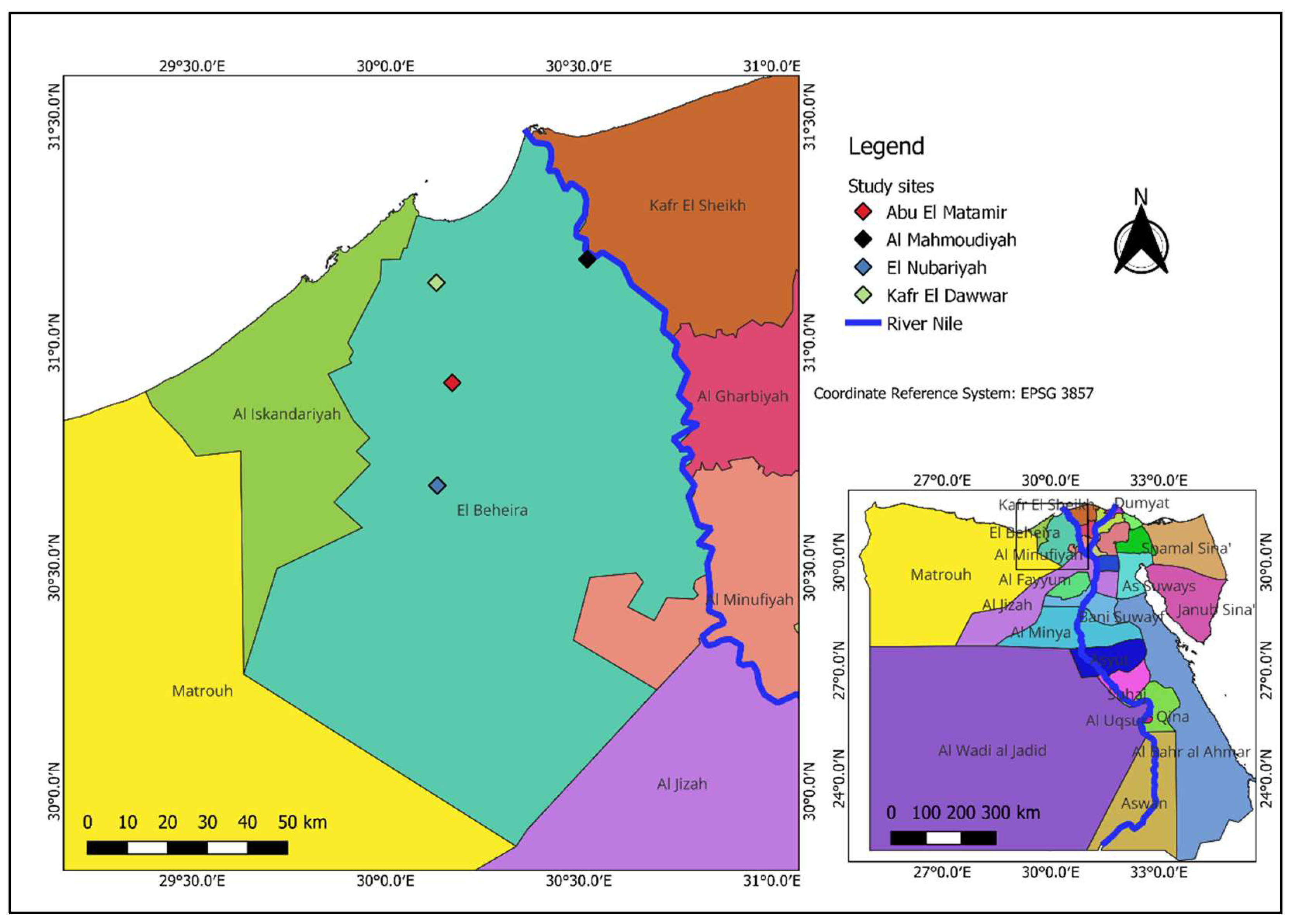
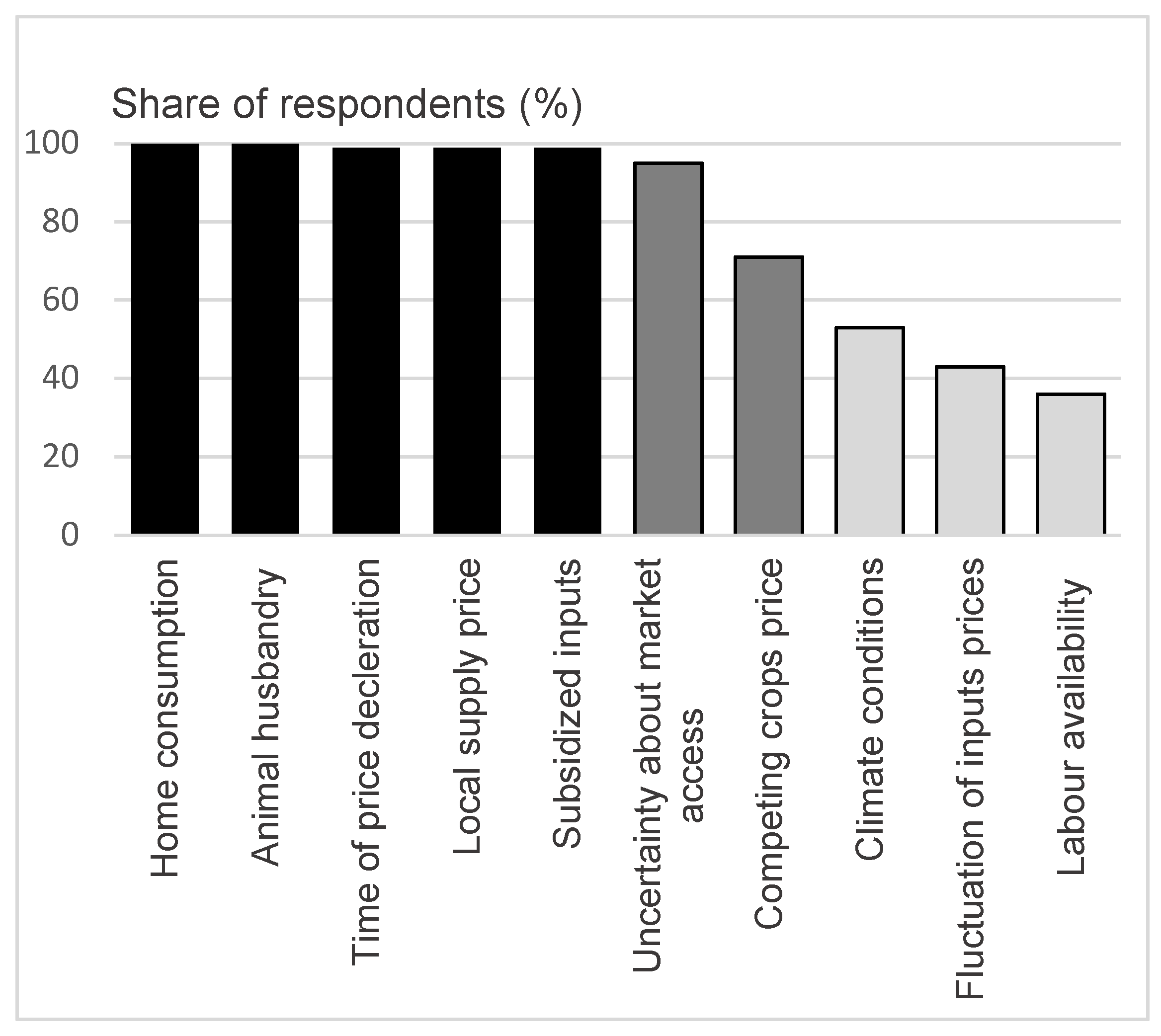
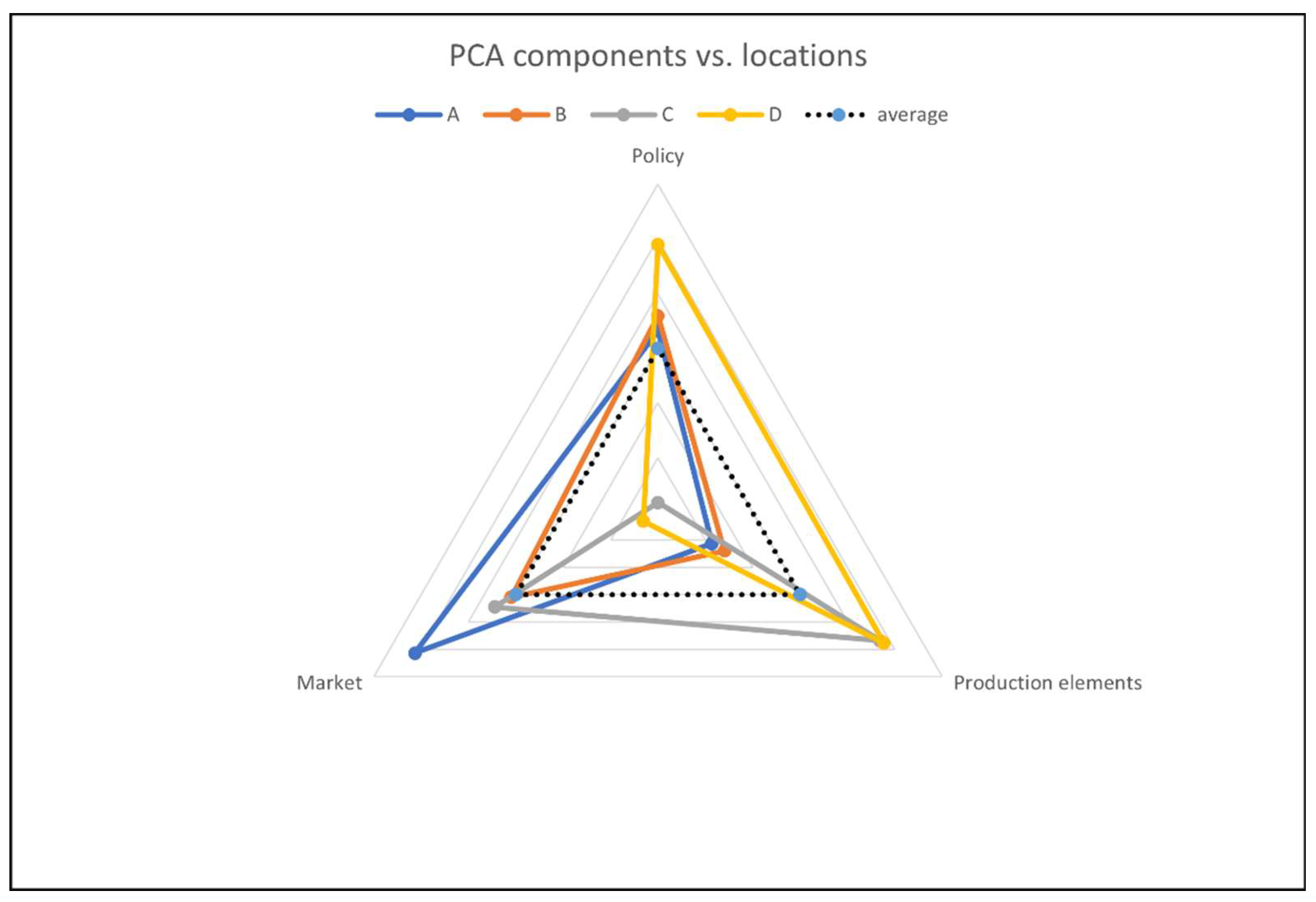
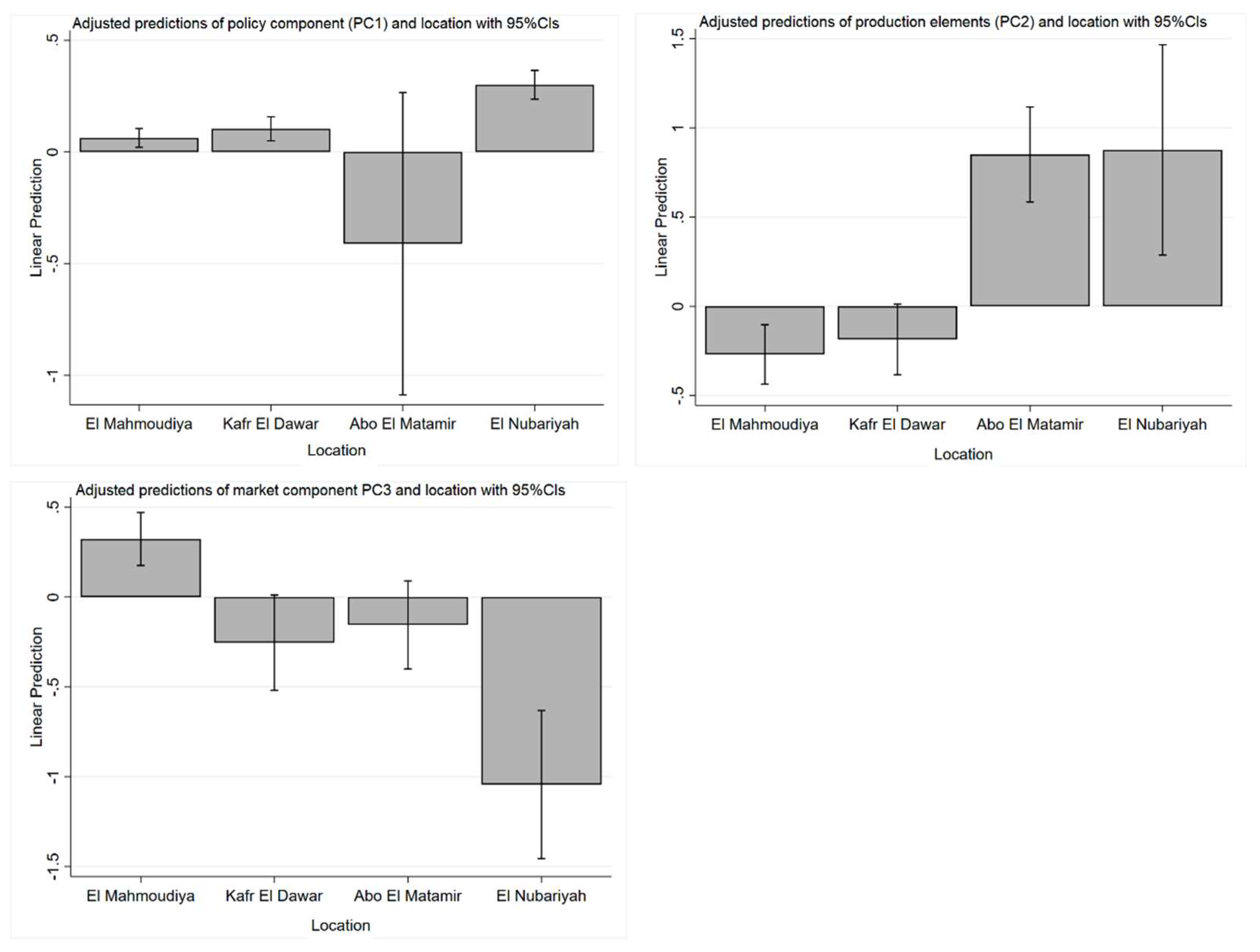
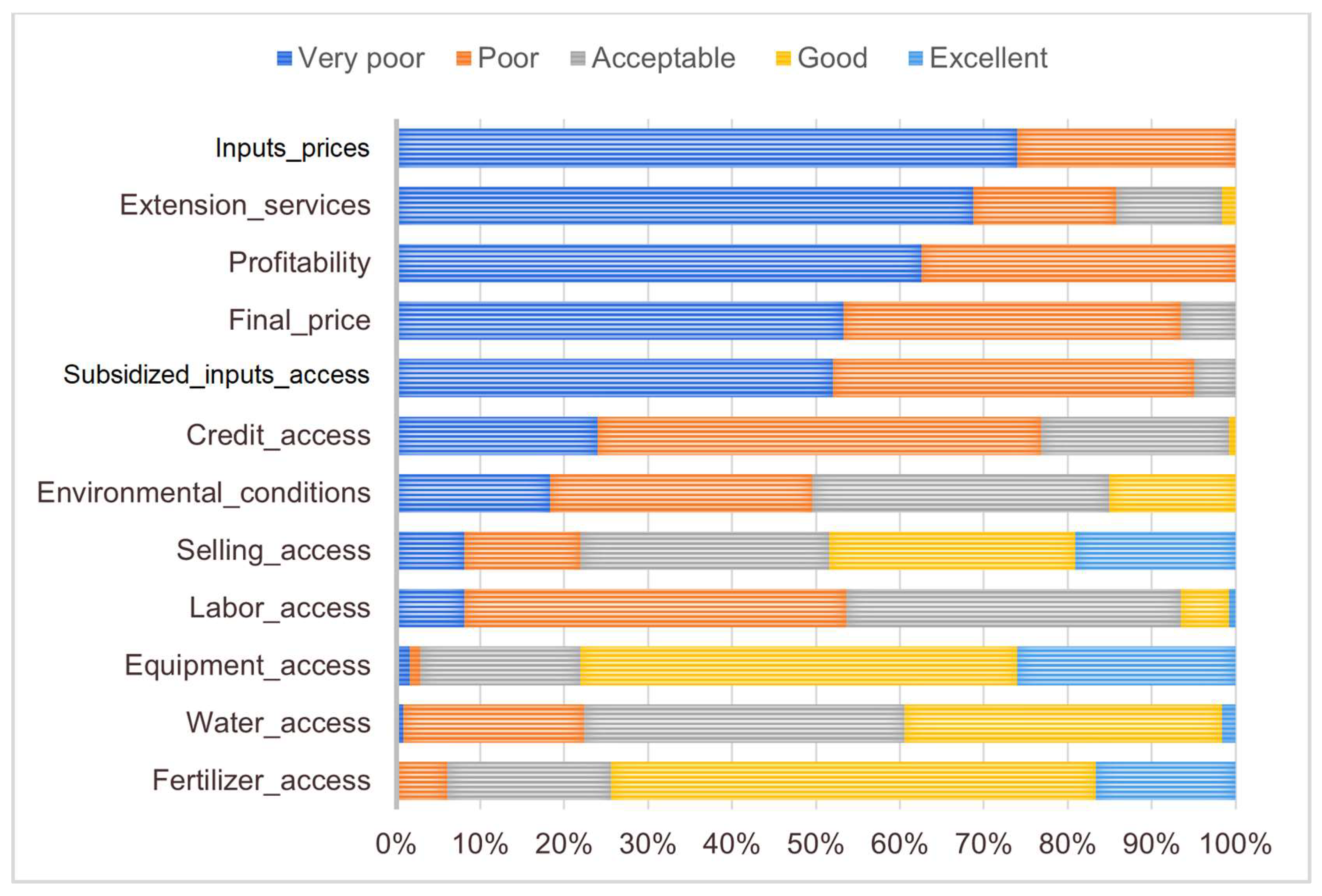

| Age of Farmer (Years) | Farming Experience (Years) | Farm Size (ha) | Wheat Yield (t/ha) | |
|---|---|---|---|---|
| Mean | 56 | 30 | 1.05 | 6.4 |
| Range | 47 | 40 | 2.1 | 4.2 |
| Minimum | 32 | 10 | 0.2 | 4.2 |
| Maximum | 79 | 50 | 2.3 | 8.5 |
| Count (n) | 246 | 246 | 246 | 246 |
| Location | Contrast | Standard Error | t | p > t | [95% Conf. Interval] | |
|---|---|---|---|---|---|---|
| B vs. A | 0.0409409 | 0.0346749 | 1.18 | 0.239 | −0.02736 | 0.109244 |
| C vs. A | −0.4734639 | 3443276 | −1.38 | 0.170 | −1.1517 | 0.204797 |
| D vs. A | 0.2378087 | 0.039233 | 6.06 | <0.001 | 0.160526 | 0.315090 |
| C vs. B | −0.5144048 | 0.3447407 | −1.49 | 0.137 | −1.1934 | 0.164670 |
| D vs. B | 0.1968678 | 0.042707 | 4.61 | <0.001 | 0.112743 | 0.280992 |
| D vs. C | 0.7112726 | 0.3452289 | 2.06 | 0.040 | 0.031235 | 1.39131 |
| Location | Contrast | Standard Error | t | p > t | [95% Conf. Interval] | |
|---|---|---|---|---|---|---|
| B vs. A | 0.0839265 | 0.1312358 | 0.64 | 0.523 | −0.17458 | 0.342436 |
| C vs. A | 1.120849 | 0.1596034 | 7.02 | <0.001 | 0.80645 | 1.43523 |
| D vs. A | 1.146599 | 0.3110838 | 3.69 | <0.001 | 0.53382 | 1.75937 |
| C vs. B | 1.036922 | 0.1685767 | 6.15 | <0.001 | 0.70485 | 1.36898 |
| D vs. B | 1.062672 | 0.3157815 | 3.37 | <0.001 | 0.44064 | 1.68470 |
| D vs. C | 0.0257498 | 0.328585 | 0.08 | 0.938 | −0.62150 | 0.673002 |
| Location | Contrast | Standard Error | t | p > t | [95% Conf. Interval] | |
|---|---|---|---|---|---|---|
| B vs. A | −0.577176 | 0.1539015 | −3.75 | <0.001 | −0.8803335 | −0.2740186 |
| C vs. A | −0.4782684 | 0.1451015 | −3.30 | <0.001 | −0.7640915 | −0.1924454 |
| D vs. A | −1.36689 | 0.2222701 | −6.15 | < 0.001 | −1.804721 | −0.9290591 |
| C vs. B | −0.0989076 | 0.1830877 | 0.54 | 0.590 | −0.2617412 | 0.4595564 |
| D vs. B | −0.7897142 | 0.2487382 | −3.17 | <0.001 | −1.279682 | −0.299746 |
| D vs. C | −0.8886218 | 0.2433915 | −3.65 | <0.001 | −1.368058 | −0.4091855 |
Disclaimer/Publisher’s Note: The statements, opinions and data contained in all publications are solely those of the individual author(s) and contributor(s) and not of MDPI and/or the editor(s). MDPI and/or the editor(s) disclaim responsibility for any injury to people or property resulting from any ideas, methods, instructions or products referred to in the content. |
© 2023 by the authors. Licensee MDPI, Basel, Switzerland. This article is an open access article distributed under the terms and conditions of the Creative Commons Attribution (CC BY) license (https://creativecommons.org/licenses/by/4.0/).
Share and Cite
Abdalla, A.; Stellmacher, T.; Becker, M. Wheat Farmers’ Perception of Constraints and Their Adaptive Capacity to Changing Demands in Egypt. Agriculture 2023, 13, 1554. https://doi.org/10.3390/agriculture13081554
Abdalla A, Stellmacher T, Becker M. Wheat Farmers’ Perception of Constraints and Their Adaptive Capacity to Changing Demands in Egypt. Agriculture. 2023; 13(8):1554. https://doi.org/10.3390/agriculture13081554
Chicago/Turabian StyleAbdalla, Ahmed, Till Stellmacher, and Mathias Becker. 2023. "Wheat Farmers’ Perception of Constraints and Their Adaptive Capacity to Changing Demands in Egypt" Agriculture 13, no. 8: 1554. https://doi.org/10.3390/agriculture13081554
APA StyleAbdalla, A., Stellmacher, T., & Becker, M. (2023). Wheat Farmers’ Perception of Constraints and Their Adaptive Capacity to Changing Demands in Egypt. Agriculture, 13(8), 1554. https://doi.org/10.3390/agriculture13081554





